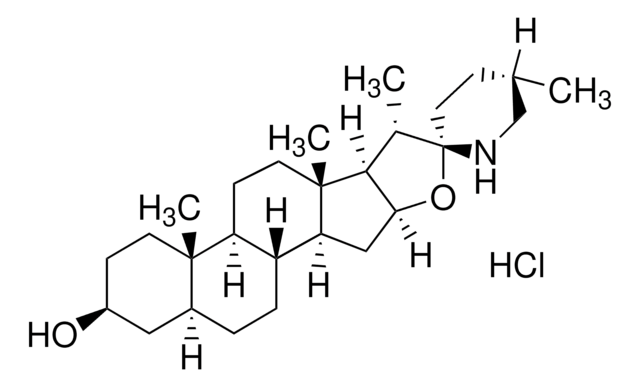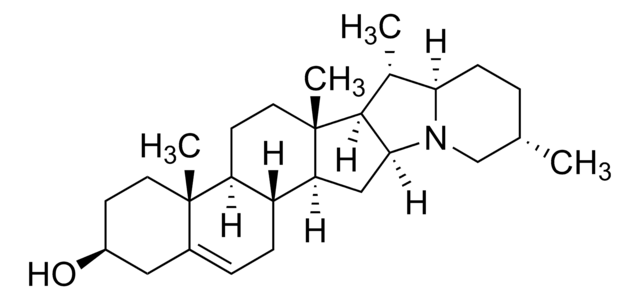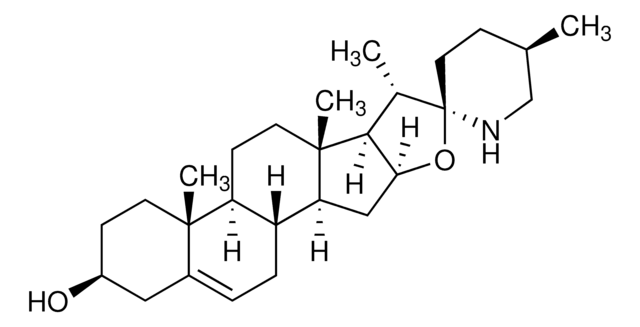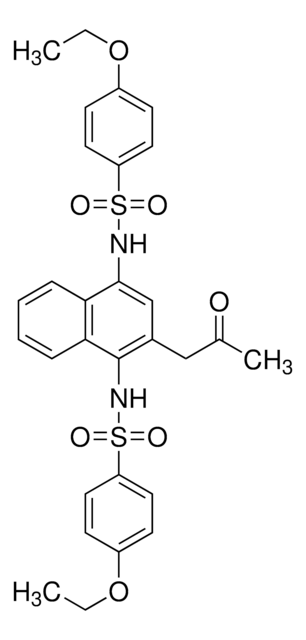T2909
Tomatidine hydrochloride
≥85%
Synonyme(s) :
3β-Hydroxy-5α-tomatidane hydrochloride, 5α-Tomatidan-3β-ol hydrochloride
About This Item
Produits recommandés
Pureté
≥85%
Température de stockage
2-8°C
Chaîne SMILES
Cl[H].[H][C@@]12CC[C@]3([H])[C@]([H])(CC[C@@]4(C)[C@@]3([H])C[C@]5([H])O[C@]6(CC[C@H](C)CN6)[C@@H](C)[C@]45[H])[C@@]1(C)CC[C@H](O)C2
InChI
1S/C27H45NO2.ClH/c1-16-7-12-27(28-15-16)17(2)24-23(30-27)14-22-20-6-5-18-13-19(29)8-10-25(18,3)21(20)9-11-26(22,24)4;/h16-24,28-29H,5-15H2,1-4H3;1H/t16-,17-,18-,19-,20+,21-,22-,23-,24-,25-,26-,27+;/m0./s1
Clé InChI
SXXHVPYRDFJKPG-XRWUXUKGSA-N
Vous recherchez des produits similaires ? Visite Guide de comparaison des produits
Description générale
Application
- to evaluate its effect on nasopharyngeal carcinoma using cell proliferation and flow cytometry assay
- as a negative control in the non-specific inhibition on hedgehog signaling in hepatocellular carcinoma cell lines
- as a control for cell growth assay and expression studies in pancreatic cancer cells
Actions biochimiques/physiologiques
Mention d'avertissement
Warning
Mentions de danger
Conseils de prudence
Classification des risques
Acute Tox. 4 Oral
Code de la classe de stockage
11 - Combustible Solids
Classe de danger pour l'eau (WGK)
WGK 3
Point d'éclair (°F)
Not applicable
Point d'éclair (°C)
Not applicable
Équipement de protection individuelle
Eyeshields, Gloves, type N95 (US)
Certificats d'analyse (COA)
Recherchez un Certificats d'analyse (COA) en saisissant le numéro de lot du produit. Les numéros de lot figurent sur l'étiquette du produit après les mots "Lot" ou "Batch".
Déjà en possession de ce produit ?
Retrouvez la documentation relative aux produits que vous avez récemment achetés dans la Bibliothèque de documents.
Les clients ont également consulté
Notre équipe de scientifiques dispose d'une expérience dans tous les secteurs de la recherche, notamment en sciences de la vie, science des matériaux, synthèse chimique, chromatographie, analyse et dans de nombreux autres domaines..
Contacter notre Service technique














